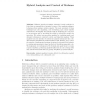Free Online Productivity Tools
i2Speak
i2Symbol
i2OCR
iTex2Img
iWeb2Print
iWeb2Shot
i2Type
iPdf2Split
iPdf2Merge
i2Bopomofo
i2Arabic
i2Style
i2Image
i2PDF
iLatex2Rtf
Sci2ools
124
Voted
RAID
2010
Springer
2010
Springer
Hybrid Analysis and Control of Malware
Abstract. Malware attacks necessitate extensive forensic analysis efforts that are manual-labor intensive because of the analysis-resistance techniques that malware authors employ. The most prevalent of these techniques are code unpacking, code overwriting, and control transfer obfuscations. We simplify the analyst’s task by analyzing the code prior to its execution and by providing the ability to selectively monitor its execution. We achieve pre-execution analysis by combining static and dynamic techniques to construct control- and data-flow analyses. These analyses form the interface by which the analyst instruments the code. This interface simplifies the instrumentation task, allowing us to reduce the number of instrumented program locations by a hundred-fold relative to existing instrumentation-based methods of identifying unpacked code. We implement our techniques in SD-Dyninst and apply them to a large corpus of malware, performing analysis tasks such as code coverage tests a...
Analysis | Code | Computer Networks | Malware | RAID 2010 |
Related Content
| Added | 30 Jan 2011 |
| Updated | 30 Jan 2011 |
| Type | Journal |
| Year | 2010 |
| Where | RAID |
| Authors | Kevin A. Roundy, Barton P. Miller |
Comments (0)

